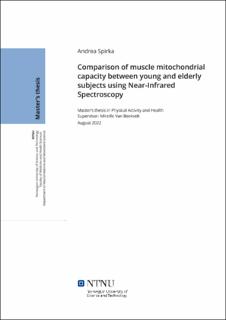| dc.description.abstract | INTRODUCTION: Aging brings many changes in the body and a drop in skeletal muscle oxidative capacity is among them. Skeletal muscle oxidative capacity or mitochondrial capacity can be investigated non-invasively with the use of Near-Infrared Spectroscopy (NIRS), by calculating the time constant (Tc). Only few studies have used NIRS to investigate differences in mitochondrial capacity between young and old subjects. The aim of the current thesis was to investigate whether there is a difference in mitochondrial capacity between healthy young and old participants after performing isolated muscle exercise and a whole-body exercise.
METHODS: In this cross-sectional experimental study, 13 young (18-40 years) and 12 old (60-80 years) non-smoking, recreationally active participants with no previous history of cardiovascular- or pulmonary diseases with a BMI < 30 were recruited through posters and social media platforms around Trondheim municipality, Norway between December 2021 and February 2022. Subjects’ flexor digitorum superficialis (FDS) muscle and vastus lateralis (VL) muscle from the right forearm and thigh were investigated with NIRS repeated occlusion (RO) method to determine mitochondrial capacity. On the first day, participants performed incremental handgrip test and an incremental cycling test to establish the individual’s maximal handgrip strength and peak power. On the second day, sustained submaximal handgrip test and cycling test were performed at 25% (WR1) and 50% (WR2) of the maximal strength and power attained on the first day. During the 4 minutes recovery periods after the exercise bouts, RO were applied, and muscle oxygen consumption (mVO2) was measured. mVO2 values were fitted to a monoexponential function to calculate the Tc.
RESULTS: There was no statistically significant difference in Tc between groups (F (1, 23.14) = 0.673; p= 0.420) regardless of the muscle or the work rate tested. A statistically significant main interaction effect of muscle (F (1, 66.53) = 15.41, p<0.001) was found, FDS muscle showed a significantly larger Tc (69.5 ± SE 4.36) value than the VL muscle (50.06 ± SE 4.35). A main interaction effect of work rate was shown (F (1, 64.89) = 31.36, p<0.001); WR2 yielding significantly larger Tc values (Tc= 73.6 ± SE 4.29) compared to WR1 (Tc= 45.96 ± SE 4.42).
DISCUSSION and CONCLUSION: No difference in mitochondrial capacity between the young and old participants was found at the relative WRs of 25% and 50% measured in FDS muscle after sustained submaximal handgrip test and in VL muscle after cycling test. VL muscle showed a superior mitochondrial capacity compared to the FDS muscle. Work rate significantly influenced the Tc, after WR2, more time was necessary for the muscle mitochondria to recover to resting values than after WR1. | |
